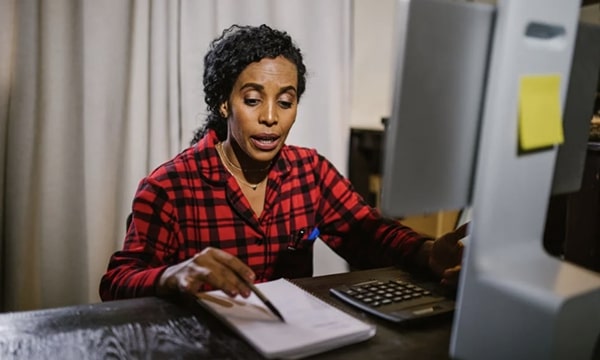 Real-time transcription and closed captioning (CC) are changing how we send and receive messaging – especially in a crowded space or when reaching out to an audience used to being bombarded with pop-ups, flashing screens, and autoplay.
Real-time transcription and closed captioning (CC) are changing how we send and receive messaging – especially in a crowded space or when reaching out to an audience used to being bombarded with pop-ups, flashing screens, and autoplay.
As a moveable audience who flips between consuming content on mobile and engaging in online meetings for work, school, and social events, if the content isn’t accessible and inclusive, it’s possible you could be missing out on key opportunities to reach and include anyone receiving your message.
You’ve definitely come across it before: Closed captioning is when spoken dialogue is transcribed and shown at the bottom of the video. Closed captions can inform the reader of sound effects, speaker identification, background music, and other labeled audible sounds.
Unlike subtitles that assume viewers don’t have hearing difficulties, closed captioning can be turned off or on and include identification of all audio sounds. On the other hand, open captions which aren’t used as much, are “burnt” onto the video or stream and are permanently attached to the video. There’s no turning them off or on.
Not only is real-time closed captioning absolutely a necessity for video content, but it’s also continually showing us just how valuable it can be when it comes to accessibility. Did you know you can use video conferencing software like FreeConference.com in conjunction with closed captioning available on Google Chrome? Together, you can make all your online meetings more accessible.
Here’s how:
- Open Google Chrome browser.
- At the top right, click the Kebab Menu (three vertical dots)
- On the drop-down, select Settings
- On the far left, select Advanced
- On the drop-down, select Accessibility
- Move the Live Caption toggle to the right.
While Google Live Captions is considered an accessibility feature, it really comes in handy across the board. It works for local audio and video files saved on a hard drive – as long as the files are played in Chrome.
Plus you can customize the font size, and color, turn on the volume for autoplay and make a few other adjustments for optimal viewing. More info here.
(alt-tag: Young woman wearing business casual, moving her hands and speaking in front of laptop on a ledge in a communal workspace.)
Here are a few of the benefits of live-caption technology:
 1. People With Hearing Disabilities Get Access To Your Content
1. People With Hearing Disabilities Get Access To Your Content
Folks who are hard of hearing are limited when it comes to watching videos, especially if captions are missing or don’t exist! Over 5% of the world’s population experience hearing loss of some degree – that’s 430 million people!
As we rely more on video content for learning, entertainment, and business purposes, people need access to content. Every country has its own compliance laws, and captioning content is a step that comes with a dramatic impact. With accessibility, comes possibility!
2. Better User Experience
Let’s face it: We watch content everywhere and we take calls and meetings from the car, on lunch breaks, or while waiting to pick up the kids! We can’t always listen to what’s happening if we’re in the presence of others, but we can still receive the message via captions. What’s helpful, too, is if during an online meeting you can’t quite make out what someone is saying, chances are, Google Live Captions will catch it.
Another option: If you’re viewing a recording of a meeting, you can take a look at the transcription that’s already included to double-check. Either way, you can’t miss an important comment, action point, or idea!
(alt-tag: Man seated, facing the right and smiling while engaged and typing on laptop on lap with piece of art in the background. )
 3. Support English-As-Second Language Speakers
3. Support English-As-Second Language Speakers
For anyone who doesn’t speak English as their first language, Google Chrome Live Caption becomes another way for learners to strengthen their learning. This is learning accelerated, especially considering how much of an educational tool captions can be. Not only are learners hearing the language, but they can also read it to help capture nuanced features like jokes, idioms, sarcasm, and so much more.
Even for English speakers, sometimes having the added option of seeing spoken words transcribed is helpful for remembering and really getting a grasp on the information.
4. More Engaging Watch Time
Some people learn by listening while others learn by watching. If you have both, just imagine how much more info you’d be able to absorb. By engaging multiple senses, your brain can receive content and be reinforced with both audio and text.
Especially in an online meeting, it’s helpful to have both audio and live captions turned on as a way to keep participants engaged.
Pro-Tip: If you’re using video conferencing software to record for training purposes or to send out recordings to participants who couldn’t attend the live meeting, encourage them to use Live Captions and see if it works to help them stay focused, keep better notes, or make for a more well-rounded experience.
Also, there’s a reason why social media giants have implemented auto-play videos without sound; People simply can’t listen to what they’re watching if they’re in mixed company, watching something confidential, or find themselves within a very limited time frame.
With Live Captions and or transcription for recording online meetings, you’re providing clients, employees, and your audience another way to receive your message. Captioning services make your content – whether internal or external, recorded or live – more memorable and far more engaging!
With FreeConference.com, you can run your meetings alongside Google Chrome’s Live Captions feature for an extra layer of inclusivity and reach. Imagine your browser-based meetings using FreeConference.com’s platform loaded with features like Screen Sharing, Smart Summaries, and transcription PLUS real-time live captions for a deeper experience. Together, your meetings can benefit even more people. Learn more here.

